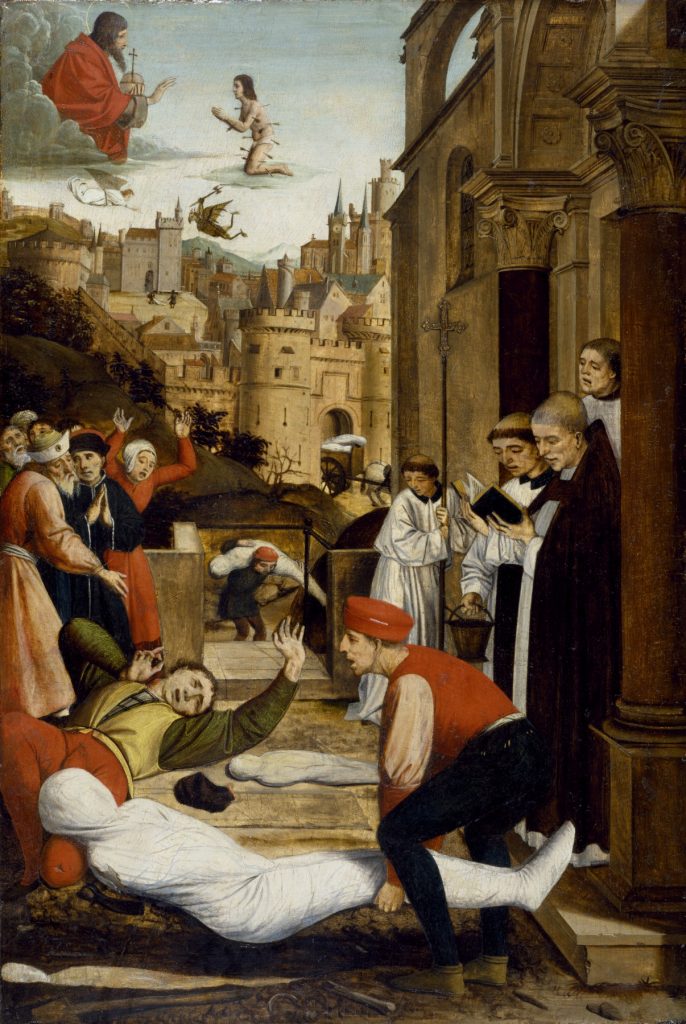There have been many epidemics that have plagued our planet over the last few thousand years; some, however, were more devastating than others. Epidemics often cause major disruptions in a society, besides simply killing people. They affect the amount of people in the workforce, which in turn can disrupt the production of goods and the food supply needed for a society.
The famous Bubonic Plague killed around a third of the population of Europe in the 1300s. The population of Europe in 1340 was about 73.5 million, and the plague affected over 20 million people. Today, Europe’s population is 508,450,856, meaning that if the plague were to have the same effects today as it did in the 1300s, it would kill around 102,000,000 people!1

The Bubonic Plague originated in the fleas carried by rodents like rats, squirrels, and prairie dogs, which transmitted the disease from one to the other. The disease spread from southwestern China to eventually the Black Sea ports of Caffa and Tana by 1346, and by 1348 it had reached northern Europe.2 The disease caused about the same symptoms in all of its victims, such as a fever, and pain so strong that they were not able to keep down any food. The name of this disease came from the fact that the people would become covered in black boils that oozed puss and blood.3 The photograph to the right is an exhibit at the Eyam Museum showing what an infected person would have looked like. The disease was highly contagious and was deadly because it worked so quickly; its victims could have been healthy one day and gone the next.

This image is of a doctor’s mask, which is similar to the masks that doctors used during the plague. These masks were believed to have protected them from breathing in the infected air. However, the masks were not very effective since many doctors contracted the disease.
This epidemic did not affect European countries in just one way, it caused major problems in many aspects of life for many areas. The continent had been battling famine and food shortages before the plague struck; then afterwards it left them in an even more compromising situation. There was a shortage of workers in the workforce, which meant that all aspects of production were affected, from food to goods and services. Try to imagine one third of the people you connect with on a regular basis completely gone. That would be a third of all the doctors, the workers you’ve encountered at the grocery store, a third of all the teachers, and even a third of one’s entire family. While this is happening, one’s entire country might already be going through a devastating famine. It is incredible that Europe was able to recover from this disaster and now has one of the largest populations in the world. The continent was able to recover from losing over a third of its population, in one of the most notorious epidemics in our world’s history, and now thrives as a largely populated and diverse part of the world.
- Josiah C. Russell, The Fontana Economic History of Europe, Vol. I: The Middle Ages, “Population in Europe,” (HarperCollins Distribution Services, 1972); European Union, “Living in the EU,” Europa.eu. (accessed November 2, 2016), http://europa.eu/european-union/about-eu/figures/living_en#tab-1-3. ↵
- Jerry H. Bentley, Herbert F. Ziegler, and Heather E. Streets-Salter, Traditions and Encounters: A Brief Global History Volume 1. 4th ed. Vol. 1. (McGraw Hill Education, 2016), 333-336. ↵
- McClain, Charles. “Of Medicine, Race, and American Law: The Bubonic Plague Outbreak of 1900,” Law & Social Inquiry 13, no. 3 (1988): 447-513. ↵



58 comments
Averie Mendez
Great article! I’m not sure how credible this is, but I read on the internet that doctor’s masks had those weird, protruding hollow beaks sticking out of them like that because they filled them with flowers in an attempt to mask the ever-lingering smell of death. Kinda crazy how quickly the continent lost one third of its entire population. Being a survivor of the Bubonic Plague must’ve been really sad because everyone lost nearly everyone they loved.
Christopher Hohman
Nice article. The Bubonic Plague was an extremely virulent disease that spread throughout much of Europe. The disease also made people question whether or not the Catholic Church deserved the power and respect it had received for so long. Many people wondered if God had punished them for some reason and because the church was unable to deliver a satisfactory answer, it lost some of its credibility. It would be even more devastating if something like this was to happen today because there are many more people who’s lives would be at stake.
Ruby Wynn
This is an interesting article. The Bubonic Plague was a terrible disease that killed one third of the people in Europe. It was extremely painful and could kill within a day. I do not understand why the doctors of the time would continue using the masks if they were ineffective. It is hard to imagine one third of the population dying and leaving so many open places in society.
Dalton Moy
I like how this article focusses on the impacts that the plague had on the countries within Europe, beside the disgusting and tragic symptoms that occurred. In high school, we even went into detail about how different groups reacted to the plague, such as the self-flagellating religious orders, however I do not remember going into how the disease effected areas economically. This is a very interesting and important topic to explore about history. I’m very glad I read this article and am contemplating this other side of a historical topic we all know too well.
Bictor Martinez
The infamous Bubonic plague we all have heard about throughout our history classes. For a disease to kill a third of a population is nuts. Living in the 1300s when the Bubonic plague was going around must have been extremely hard to bear. Just knowing your loved ones hearing they got the deadly disease must hurt. This article was well written and able to successfully describe the Bubonic plague. Great article.
Indhira Mata
I had only focused on one of the effects of the disease and did not realized that it had such a larger effect on the country. Personally, I had assumed that losing a third of the population was enough damage, but it came with a lot more. Those unaffected would soon die too because of supply shortage during the time since the disease was killing everyone. The article was well written that it made me go back and make sure I understood the new discoveries.
Christopher Hohman
Nice article. The Bubonic Plague was a terrible disease that afflicted so many people. I think that it is kind of ironic that during the early part of the renaissance as people’s lives were getting better and nations were developing more complex ways of governing this plague came and almost wiped all that out. One of the effects of increased trade I suspect. The same thing happened to the Romans and Chinese peoples. It is also really interesting how the plague effected the status of the church in Europe. Many people began to question the churches authority after the plague because they thought God was angry at them and the church had no solid answers
Esperanza Rojas
I really liked the images provided. With this being such a big topic, I thought the article was going to be some information that was going to be repeated, but it wasn’t. It showed how the Bubonic Plague affected the countries of Europe. It put it into perspective of how one thirds of the population would die out, with one thirds teachers, workers, and someone’s family, so it wasn’t just an emotional time but economically and socially.
Luke Lopez
This was a very interesting article on the Bubonic Plague. It is unimaginable that the plague affected 20 million people in Europe. I remember reading about the Bubonic Plague in high school, and how quickly this plague spreads throughout the body. This plague was also deadly, because of how contagious it was. Overall, this was a great article that described the Bubonic Plague.
Valeria Perez
It is because of events like this that I am happy to be part of this century. The symptoms and speed of this plague is horrifying. We constantly take our medicine and technology for granted, but we had to suffer and learn from the death of many before us.
It is horrible that so many people died and that there was nothing they could do about it. And because the effects were so large and widespread, how much time did it take for the societies to recover?